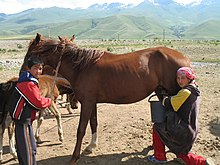Mare milk
Appearance


Mare milk is milk lactated by female horses, known as mares, to feed their foals. It is rich in whey protein, polyunsaturated fatty acids and vitamin C,[1] and is a key ingredient in kumis. In several European countries, including Germany, it is sold powdered.[1]
Mare milk is sometimes chosen over cow milk for its purported health benefits.[2] A niche market considers it a remedy for skin or digestive problems. Peer-reviewed papers suggest it can reduce atopic dermatitis or eczema.[3] It is used to make cosmetics and can form cheese with camel rennet, but not bovine.[4]
See also
[edit]References
[edit]- ^ a b Young W. Park; George F. W. Haenlein, eds. (2008). Handbook of Milk of Non-Bovine Mammals. John Wiley & Sons. p. 293. ISBN 978-0470999721.
- ^ Szkolnicka, Katarzyna; Mituniewicz-Małek, Anna; Dmytrów, Izabela; Bogusławska-Wąs, Elżbieta (7 August 2024). "The use of mare's milk for yogurt ice cream and synbiotic ice cream production". PLOS ONE. 19 (8): e0304692. Bibcode:2024PLoSO..1904692S. doi:10.1371/journal.pone.0304692. PMC 11305560. PMID 39110654.
- ^ Forrest, Susanna (July 12, 2018). "Mare's Milk For Health? Europeans Look To Horses For Ancient Remedy". NPR. Retrieved August 17, 2020.
- ^ Technique developed to make cheese from horse and donkey milk

